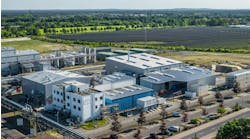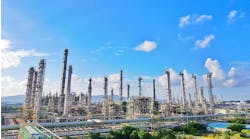Reboilers provide vapor for a distillation tower. The most common type of reboiler is some variant of a shell-and-tube (S&T) exchanger — because such exchangers can satisfy a wide range of process and mechanical requirements at reasonable costs.
Basic reboiler configurations include:
• Kettle. These are TEMA K-type exchangers with shell-side vaporization. They hold a boiling liquid pool on a tube bundle, either by level or use of an internal overflow weir.
• Thermosyphon. Density difference between the inlet liquid and the outlet vapor/liquid mixture drives the liquid. Vertical types may have the vaporization on either the tube-side, which is most common, or shell-side. Horizontal types nearly always have boiling on the shell-side. Systems can be once-through or include recirculation (recycle of liquid in the outlet). Recirculation allows for higher total vapor output at a low vaporization fraction on each pass. Vertical thermosyphons in vacuum services often suffer from boiling point suppression due to static head.
• Forced circulation. An external pump forces liquid through the exchanger. Flow may be either once-through or recirculating.
• Stab-in bundle. Basically an S&T exchanger without the shell, it most often is a U-tube bundle but any type of internal head can be used. The tube bundle is inserted into a liquid pool in the vessel. The major benefit is elimination of external piping. This design frequently is chosen for services where minimizing potential piping leaks is critical or experience has shown the service is very clean and minimal bundle maintenance is likely to be necessary.
• Horizontal. This particularly suits applications needing a larger surface area. A larger shell weighs more — removing it from the bundle for cleaning is much easier when the shell is horizontally mounted.
• Vertical. Such an exchanger requires little plot area. So, it may appeal if space is tight. However, cleaning large vertical shells can pose challenges due to the difficulty and clearances necessary in pulling a large bundle vertically.
• Falling film. This usually consists of a vertical exchanger with tube-side vaporization. A distributor places liquid on an inside tube surface; the falling film of liquid vaporizes as it descends. Vapor and liquid flow may be either co-current or counter-current. Most co-current units use pumps to allow locating the reboiler above the liquid draw from the tower. This reduces vertical height required. A co-current exchanger minimizes liquid residence time in heat-sensitive systems. Because no static head from liquid is on the vaporizing liquid, a co-current unit well suits many vacuum services with heat-sensitive components. However, at high vaporization levels, a falling film exchanger requires complex and expensive liquid distribution systems to prevent tubes without sufficient liquid from drying out.
In reboiler selection some critical choices include whether to: vaporize on the shell side or tube side; rely on gravity flow or forced flow; orient the unit vertically or horizontally; opt for a flow-through or kettle design; and install baffles inside the tower. Often, no single design meets every requirement for a specific service and, thus, making a choice demands balancing capital cost, operating cost and performance factors.
Table 1 summarizes guidelines for many general situations. It includes a mix of mechanical and process factors that influence selection. Some considerations are general and difficult to quantify. In certain cases, strong recommendations can be made — here, notes provide guidance about the relative importance of the factors.
ANDREW SLOLEY is a Chemical Processing Contributing Editor. You can e-mail him at [email protected]



